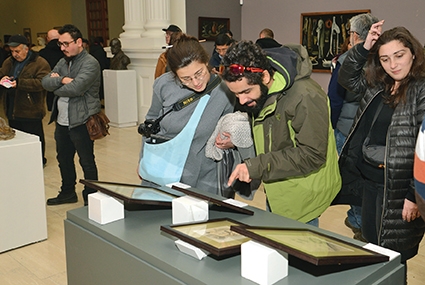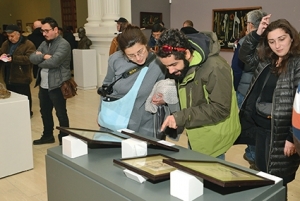Iakob Nikoladze: From Rodin to Georgia
The Georgian National Museum Dimitri Shevardnadze National Gallery is holding an exhibition dedicated to the 140th anniversary of Iakob Nikoladze. The opening event took place on November 29.
Iakob Nikoladze is the founder of modern Georgian sculpture. His art came to light in the late 19th century and beginning of the 20th, when Georgia was returning to the bosom of European culture and sculpture was increasing in popularity once again.
In 1906-1908, over 15 months, Nikoladze worked with the greatest sculptor of modernity - Auguste Rodin. Despite a number of suggestions to work in Europe and America, Nikoladze decided to bring the experience gained with Rodin back to Georgia and to set up a school of sculpture in his home country. Nikoladze, founder of Georgian realistic sculpture, was one of the founders of the Tbilisi Academy of Fine Arts.
Guram Nikoladze is his grandson from his mother’s side. Bearing his honorable grandfather’s surname, Guram is also a sculptor, as well as the director of the Iakob Nikoladze House-Museum.
“Even though I don’t remember my grandpa, as he died in 1951 and I was born in 1954, I was always surrounded by his works at home. I was planning on entering the faculty of painting but my mother, Iakob’s daughter, advised me to choose her father’s path,” Guram told GEORGIA TODAY.
Davit Lortkipanidze, Director General of the Georgian National Museum, opened the recent exhibition.
“If we ask who was number one for sculpture in Georgia, there is no question about the answer: Iakob Nikoladze,” Lortkipanidze enthused. “Such a large exhibition of Nikoladze’s works has never taken place in the history of independent Georgia. It aims to make us realize together that we need to be familiar with those who wrote Georgian history. Nikoladze showed that Georgians can be successful in all spheres, including sculpture, which was not naturally well-developed in those days. Let’s continue this tradition and get our museum exhibits out of their bags and give society a chance to see and enjoy them.”
“Iakob Nikoladze was a person who created the history of Georgia even while he was still alive,” said Mikheil Giorgadze, returnee to the post of Minister of Culture and Monument Protection. “He was the founder of Georgian realistic sculpture. For people of my generation and younger, this is the first time we’ve had a chance to see these sculptors ‘live.’ I’m sure that the exhibition will raise great interest in Georgian society. We are also presenting an album detailing the life and creative work of Nikoladze with the support of our ministry and that of the Tbilisi City Hall Center of Cultural Events.”
“We are celebrating the jubilee of an artist whose importance is irreplaceable in the history of Georgian culture,” Eka Kiknadze, curator of this rare and memorably exposition, said briefly. “I am sure that more and more spectators will come to see these works.”
On display are a series of busts of Shota Rustaveli, Petre Melikishvili and Galaktion Tabidze; imposing, made in marble, stone and gypsum. And an exquisite series of women: ‘Dancer,’ ‘Parisian Woman,’ and ‘Naiada.’
While studying in France, Nikoladze took part in fulfilling the orders of Rodin, among which is the portrait of D’Oreville, which Rodin liked so much that he decided to make not one change to the face. ‘The Wind’ is one of Nikoladze’s most impressive works, expressed in the form of a woman standing in windy weather, demonstrating plasticity, as do ‘Salome,’ ‘Dancer’ and ‘A Girl from the North.’
Following the establishment of the Tbilisi State Academy of Arts, Nikoladze led the Faculty of Sculpture and worked with students until the end of his days. As the students remember, he constantly repeated the words which he was told by Rodin: Work as you sing, but more loudly!
The exhibition ‘Iakob Nikoladze 140’ showcases artworks, photos, documentary and memorial material from the various establishments: the Georgian National Museum Shalva Amiranashvili Museum of Fine Arts, the Iakob Nikoladze House-Museum, the National Archives of Georgia, the Georgian State Museum of Theater, Music, Cinema and Choreography, the Giorgi Leonidze State Museum of Georgian Literature as well from numerous private collections.
WHERE: Dimitri Shevardnadze National Gallery, 11 Rustaveli Ave. Tbilisi
WHEN: Until February 28, 2017
Maka Lomadze











